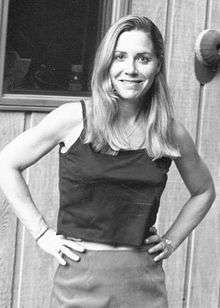Ginna Marston
Ginna Sulcer-Marston (born Ginna Sulcer February 19, 1958 in Chicago, Illinois) is an American advertising executive notable for anti-drug public service advertising campaigns at the Partnership for a Drug Free America, a nonprofit consortium of advertising professionals which ran targeted media campaigns to unsell illegal drugs.[6] She was a founder of the organization in 1986[6] which produced the well-known commercial This is your brain on drugs[7] and other "hard-hitting, unsentimental ads" which depicted the "unglamorous reality of drug abuse".[8] As research director,[9] she studied the consumer motivations of drug users by means of marketing research methods including focus groups, quantitative surveys, and advertising research,[4][10][11] and she led media campaigns directed at specific audiences such as inner-city youth,[12] pre-teens,[13] and parents.[11] In addition, she often served as the organization's spokesperson,[7][14] by giving speeches at numerous press conferences, by speaking at universities such as Colgate University,[15] appearing on television,[16] in print media,[17][18][19] and on radio.[20] She is regarded as an authority on anti-drug advertising efforts.[21]
Ginna Marston | |
|---|---|
 | |
| Born | Ginna Mary Sulcer February 19, 1958 Chicago, Illinois, U.S. |
| Nationality | American |
| Education | Phillips Exeter Academy |
| Alma mater | Princeton University |
| Occupation | Advertising |
| Years active | 27+ years |
| Employer | Ted Bates (1980–1986) PDFA (1986–2007) |
| Home town | Chicago, Illinois, U.S. |
| Spouse(s) | Michael Marston[1] |
| Children | Quinn Marston, son |
| Parent(s) | Sandy Sulcer, father[1][2] Dorothy Wright (artist), mother |
| Awards | PDFA campaign awards: Gold Effie 1993, 1994[3] Grand Effie 1994[4][5] |
Beginnings

Marston is the daughter of late advertising agency executive and copywriter Sandy Sulcer[2] who has been credited for co-writing the Put a Tiger in Your Tank advertising theme for Exxon along with Ernest Dichter. She graduated cum laude from Phillips Exeter Academy in 1976. She graduated cum laude with an A.B. in comparative literature from Princeton University in 1980 after completing a 329-page long senior thesis titled "The Grotesque as a Comparative Concept in Modern Narrative: Donoso, Gautier, Poe, Hoffman, Balzac."[22][1] She worked at the Ted Bates advertising agency before joining the Partnership for a Drug-Free America in 1986 as one of the founders.
Partnership for a Drug-Free America
The agency was formed during the middle 1980s by key professionals working under the auspices of the American Association of Advertising Agencies, and included Phillip Joanou, Thomas Hedrick, Doria Steedman, and Marston. The thinking was that if advertising could create demand for helpful consumer products such as toothpaste and soft drinks, then advertising could shrink demand for dangerous addicting substances such as illegal drugs. Grants from the advertising association, the Robert Wood Johnson Foundation, and a wide assortment of businesses provided funding to enable the agency to operate.[23]
The first priority was understanding attitudes associated with decisions to use drugs, and the organization devoted substantial resources towards studying these motivations. Marston identified two key perceptions involved with the decision by young kids to experiment with drugs: (1) the risk to the user and (2) possible social disapproval, and the resulting media campaigns focused on both messages.[9] The group collaborated with anti-drug crusaders such as Carole Fields-Arnold.[24] Marston described the Partnership's mission:
We're trying to break that age-old stereotype of sex, drugs, rock-'n'- roll going together with everything cool, and saying that drug use is not cool, and most people are not doing it, and even some of the coolest people that you look up to like Lauryn Hill or Dixie Chicks are willing to come forward and say, we're drug-free. So that's a very different message for kids that makes it a valid option not to use drugs and know that you're in the majority.
— Marston in 2000[25]
In the middle of the 1990s, research suggested that not only teenagers were vulnerable to drugs, but pre-teenagers as well, and Marston led an advertising effort to discourage early experimentation.[13][26] She worked with retired Johnson & Johnson chief executive James E. Burke.[27] She led anti-drug advertising efforts geared towards inner-city youth,[4][12] and towards discouraging use of specific substances such as heroin,[9][28] Ecstasy,[29] and marijuana.[30] The organization focused anti-drug messages on parents too:
Parents are a crucial target audience, and research shows the boomer parents are out-of-touch with the vulnerability of their kids to drug experimentation. So, raising the sense of urgency appropriately has been effective with them.
— Marston, in an interview in 2000.[11]
Marston advised the National Institutes of Health on anti-drug advertising strategies,[21] and urged game designers to not glamorize drugs in video games.[31] In 1999, she appeared in the Robert Zemeckis film entitled Smoking, Drinking and Drugging as a spokesperson.[7] The decades-long effort by the Partnership has been studied written up in case-studies for the Harvard Business School as well as educational presentations for the Advertising Educational Foundation.[11]
Personal life
_production_assistant_(center)_Ginna_Marston_(right).jpg)
_Ginna_Marston_(center)_Bill_Cosby_(right).jpg)
Marston is married with two children. In addition to advertising, Marston is a singer-songwriter and has performed in local venues.[32] Her son, Quinn Marston, is a singer-songwriter.
Publications
- Marston, Ginna Growing up Drug Free: A Parent's Guide to Prevention, Sally Marshall (editor), Diane Publishing Company, published April 1, 1999, ISBN 9780788178023
See also
- Partnership at Drugfree.org, the current name of the Partnership for a Drug-Free America
- Quinn Marston, son
- Frederick D. Sulcer, father
References
- "Michael Marston Weds Ms. Sulcer". The New York Times. July 20, 1986. Retrieved May 7, 2012.
- "Deaths SULCER, FREDERICK D. SANDY". The New York Times. January 25, 2004. Retrieved May 7, 2012.
- "The Inner-City Anti-Drug Campaign (1994 EFFIE)". Partnership for a Drug Free America. 1994. Retrieved May 10, 2012.
In 1994, the New York chapter of the American Marketing Association presented The Partnership and Goodby Berlin & Silverstein with advertising's most coveted award – the Gold "EFFIE" – for the effectiveness of its national, anti-drug public service advertising campaign. It was also the first time a public service campaign had won back-to-back Gold awards (1993 and 1994).
- Rachel Rosenthal (July 11, 1994). "HELPING STEM DRUG USE PARTNERSHIP'S ADS SHOW INFLUENCE ON URBAN KIDS". Advertising Age. Retrieved May 7, 2012.
- "The Inner-City Anti-Drug Campaign (1994 EFFIE)". Partnership for a Drug Free America. 1994. Retrieved May 10, 2012.
... The Partnership's campaign was presented with arguably the highest level of recognition afforded a communications campaign – the "Grand EFFIE" which represents the single most effective advertising campaign in America -...
- "Sulcer, 77, Former DDB Needham Exec, Dies". Adweek. January 23, 2004. Retrieved May 7, 2012.
... Ginna Marston ... co-founded the nation's nonprofit media campaign against drug abuse, Partnership for a Drug-Free America, in 1986.
- Andy Meisler (August 29, 1999). "TELEVISION/RADIO; Getting Down to What Makes America High". The New York Times. Retrieved May 7, 2012.
- Mariko Fujinaka (2000). "Media-Advertising Partnership for a Drug-Free America: Antidrug Public-Service campaign (case study)". warc. Retrieved May 7, 2012.
- PAMELA WARRICK (August 30, 1996). "Can You Just Say No? Since 1985, the Partnership for a Drug-Free America—with the ad world's best and free media exposure—has been an ally in the war on drugs. New target: heroin". Los Angeles Times. Retrieved May 7, 2012.
- RANDALL ROTHENBERG (January 17, 1990). "THE MEDIA BUSINESS: Advertising; People". The New York Times. Retrieved May 7, 2012.
- "Ginna Marston, Executive Vice President, Partnership for a Drug Free America". Advertising Educational Foundation. April 4, 2000. Retrieved May 7, 2012.
(transcript)
- PDFA (2003). "The Inner-City Anti-Drug Campaign (1994 EFFIE)". Advertising Educational Foundation. Retrieved January 3, 2012.
- Times Staff and Wire Reports (March 5, 1997). "Preteen 'Pot' Use Doubles, Study Says". Los Angeles Times. Retrieved May 7, 2012.
- Kathleen Fackelmann (December 16, 2002). "Survey: Teen drug use on decline". USA Today. Retrieved May 7, 2012.
- Staff writer (July 1999). "Around the college". The Colgate Scene (Colgate University). Retrieved May 7, 2012.
...Ginna Marston of the Partnership for a Drug-Free America discussed "Does pop culture influence drug attitudes? Drugs, teens, and the media."...
- "Mothers Against Drunk Driving (MADD) President Karolyn Nunnallee and Partnership For a Drug-Free America's Ginna Marston Discuss Alcohol Advertising\n". NBC News. June 14, 1999. Retrieved May 7, 2012.
- ROBERT CROWE (August 5, 2006). "Some skeptical of new anti-drug campaign: Ads equating addiction with a disease provoke strong response". Houston Chronicle. Retrieved May 7, 2012.
- Associated Press (June 30, 1990). "Doctor: Anti-Drug 'Hype' Harms Anti-Drug Cause". Sarasota Herald-Tribune. Retrieved May 7, 2012.
- Nancy Doyle Palmer (February 26, 2007). ""You've Got to Stop" – When alcoholism or drug addiction takes over someone's life, an intervention can be the first step toward recovery. Here's how the process works—and where to get help". Washingtonian. Retrieved May 7, 2012.
- Maryanne Zeleznik (February 25, 2006). "Cincinnati Edition Archive". WVXU 91.7 Radio. Retrieved May 7, 2012.
Maryanne Zeleznik learns more from Ginna Marston of The Partnership for a Drug-Free America ...
- National Institutes of Health (2002). "National Conference on Drug Addiction Treatment: From Research to Practice". National Institute on Drug Abuse. Retrieved May 7, 2012.
Ginna Marston: Partnership for a Drug-Free America
- Sulcer, Ginna Mary (1980). "The Grotesque as a Comparative Concept in Modern Narrative: Donoso, Gautier, Poe, Hoffman, Balzac". Cite journal requires
|journal=(help) - Penny Singer (November 10, 1991). "Small Businesses Focus On Drugs in Workplace". The New York Times. Retrieved May 7, 2012.
- Myrna Oliver (July 16, 2004). "Carole Fields-Arnold, 59; Talent Agent Co-Founded Drug, Alcohol Program". The New York Times. Retrieved May 7, 2012.
- "Newsroom/World View: Newsroom for February 3, 2000". CNN. February 3, 2000. Retrieved May 7, 2012.
- Treaster, Joseph B. (October 2, 1992). "THE MEDIA BUSINESS; Television Ads Are Directed At Urban Youths and Drugs". The New York Times. Retrieved May 7, 2012.
- CHRISTOPHER S. WREN (February 20, 1996). "Marijuana Use by Youths Continues to Rise". The New York Times. Retrieved May 7, 2012.
- JERRY CROWE (July 14, 1996). "Heroin Deaths Fuel Music Industry's Soul-Searching". Los Angeles Times. Retrieved May 7, 2012.
- "Study: Teen Ecstasy Use Rising Fast". ABC News: Good Morning America drawing the teen set. February 11, 2002. Retrieved May 7, 2012.
- Mark Bowden (September 3, 1987). "After 20 Years, Pot Use Continues To Trouble". Philadelphia Inquirer. Retrieved May 7, 2012.
- Michael Colton (June 18, 1998). "To Some Critics, N2O's: Not A Gas Ads for Video Game, Featuring Nitrous Oxide Evoke Drug Culture". Washington Post. Retrieved May 7, 2012.
- Check with PERFORMERS ... Ginna Marston Otis Cultural Council Minutes June 16, 2008 Archived March 4, 2016, at the Wayback Machine